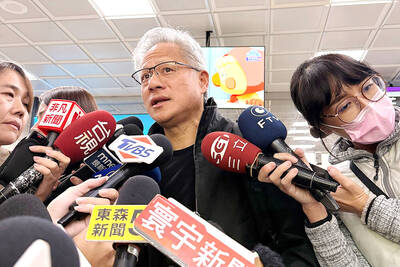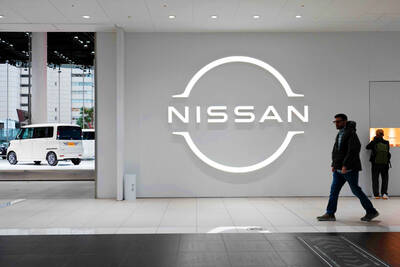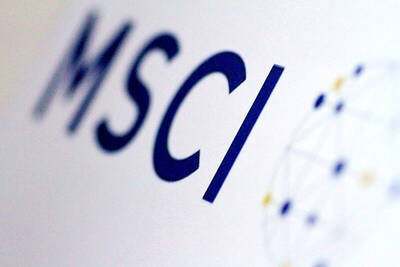Xiaomi Corp’s (小米) international chief Hugo Barra has quit after a turbulent four years during which the Chinese smartphone maker rose to the top of its home market before local rivals mimicked its model and dethroned the brand.
The former Google executive is returning to Silicon Valley after being hired with much fanfare in 2013 to be Xiaomi’s global face, becoming a fixture on the conference circuit and the up-and coming vendor’s main pitchman to foreign audiences.
Barra wrote on Facebook yesterday that it was time for him to return home to embark “on a new adventure,” without elaborating.
Xiaomi senior vice president Xiang Wang (王翔) is to oversee global operations after Barra departs next month, after the Lunar New Year holiday.
Barra was given the task of taking Xiaomi global, helping the company make inroads into India, where sales topped US$1 billion for the first time last year. During his tenure, it briefly became China’s biggest smartphone vendor by packing high-end components into inexpensive devices and building a vibrant online community of users.
However, local brands such as Oppo (歐珀移動), Vivo (維沃移動) and Huawei Technologies Co (華為) rapidly copied its moves and developed more innovative competitive tactics.
“Hugo was a key figure for Xiaomi in the early days because he helped overseas marketing,” said Kitty Fok, managing director of International Data Corp China.
Barra’s departure is likely to have limited impact because Xiaomi’s position in India has stabilized and the task has shifted to growing market share, Fok said.
His exit might indicate that Xiaomi is refocusing on its home market, Canalys analyst Nicole Peng said.
Barra would be leaving Beijing just as Xiaomi is struggling to find its footing at home.
“What I’ve realized is that the last few years of living in such a singular environment have taken a huge toll on my life and started affecting my health,” Barra wrote in his post. “Seeing how much I’ve left behind these past few years, it is clear to me that the time has come to return.”
Xiaomi was last valued at US$45 billion in 2014, making it one of the world’s largest start-ups. It drew comparisons to Apple Inc after doubling revenue that year and climbing to the top of the Chinese smartphone market.
It has since struggled, missing its 2015 shipments target and falling behind Oppo and Huawei. The company is aiming for 100 billion yuan (US$14.5 billion) in revenue this year — the same target it had set as far back as 2015.
Since that valuation in 2014, analysts have questioned its price tag given a sliding market position.
In a memo posted on his WeChat account, billionaire cofounder Lei Jun (雷軍) said his company had tried to grow too rapidly in past years and missed opportunities.
It has had more success in India, where it grew shipments 150 percent last year. Chinese brands account for 51 percent of India’s smartphone shipments in November last year, according to Counterpoint Research.
Xiaomi is counting on the country to drive its next phase of growth: It already assembles more than three-quarters of its Indian smartphones in the country under the government’s “Make in India” program.
Despite that success, Xiaomi’s most important market by far remains its home country, where it might be preparing a comeback.
“Xiaomi realized the Chinese smartphone market will be their top priority,” Peng said. “India was the only shining point for Xiaomi’s overseas expansion over the years and entering the US market will not be easy, because the market is strongly held by Apple and Samsung.”
Xiaomi secured US$1.1 billion in 2014 from investors, including GIC Pte, All-Stars Investment Ltd and DST.
Executives have since said that it is not on the hunt for financing, while deflecting speculation about an initial public offering.
Apart from phones, the company also sells other types of electronic gadgets and appliances, from air purifiers to robot vacuums, made by what it calls its ecosystem-partners.
Sales through such manufacturing and branding partners exceeded 15 billion yuan last year, Lei has said.

PERSISTENT RUMORS: Nvidia’s CEO said the firm is not in talks to sell AI chips to China, but he would welcome a change in US policy barring the activity Nvidia Corp CEO Jensen Huang (黃仁勳) said his company is not in discussions to sell its Blackwell artificial intelligence (AI) chips to Chinese firms, waving off speculation it is trying to engineer a return to the world’s largest semiconductor market. Huang, who arrived in Taiwan yesterday ahead of meetings with longtime partner Taiwan Semiconductor Manufacturing Co (TSMC, 台積電), took the opportunity to clarify recent comments about the US-China AI race. The Nvidia head caused a stir in an interview this week with the Financial Times, in which he was quoted as saying “China will win” the AI race. Huang yesterday said

Nissan Motor Co has agreed to sell its global headquarters in Yokohama for ¥97 billion (US$630 million) to a group sponsored by Taiwanese autoparts maker Minth Group (敏實集團), as the struggling automaker seeks to shore up its financial position. The acquisition is led by a special purchase company managed by KJR Management Ltd, a Japanese real-estate unit of private equity giant KKR & Co, people familiar with the matter said. KJR said it would act as asset manager together with Mizuho Real Estate Management Co. Nissan is undergoing a broad cost-cutting campaign by eliminating jobs and shuttering plants as it grapples

The Chinese government has issued guidance requiring new data center projects that have received any state funds to only use domestically made artificial intelligence (AI) chips, two sources familiar with the matter told Reuters. In recent weeks, Chinese regulatory authorities have ordered such data centers that are less than 30 percent complete to remove all installed foreign chips, or cancel plans to purchase them, while projects in a more advanced stage would be decided on a case-by-case basis, the sources said. The move could represent one of China’s most aggressive steps yet to eliminate foreign technology from its critical infrastructure amid a

MORE WEIGHT: The national weighting was raised in one index while holding steady in two others, while several companies rose or fell in prominence MSCI Inc, a global index provider, has raised Taiwan’s weighting in one of its major indices and left the country’s weighting unchanged in two other indices after a regular index review. In a statement released on Thursday, MSCI said it has upgraded Taiwan’s weighting in the MSCI All-Country World Index by 0.02 percentage points to 2.25 percent, while maintaining the weighting in the MSCI Emerging Markets Index, the most closely watched by foreign institutional investors, at 20.46 percent. Additionally, the index provider has left Taiwan’s weighting in the MSCI All-Country Asia ex-Japan Index unchanged at 23.15 percent. The latest index adjustments are to